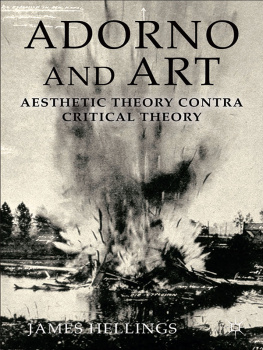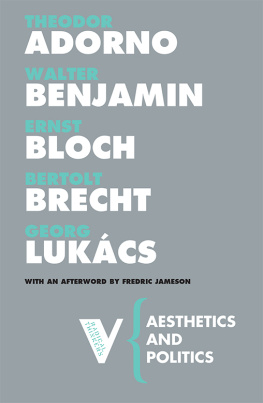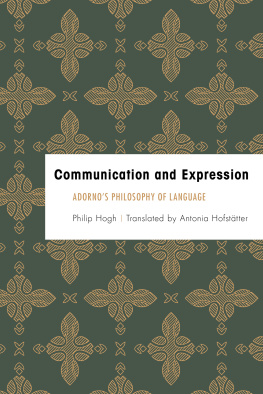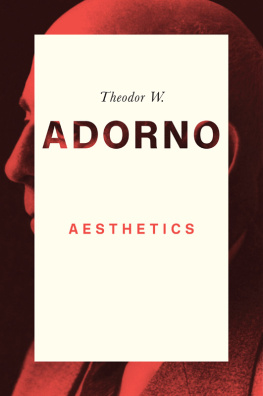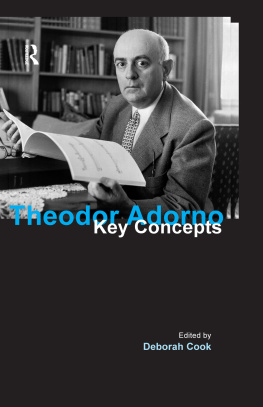Adorno and Art
Adorno and Art
Aesthetic Theory Contra Critical Theory
James Hellings
School of Art, BIAD, Birmingham City University, UK


James Hellings 2014
All rights reserved. No reproduction, copy or transmission of this publication may be made without written permission.
No portion of this publication may be reproduced, copied or transmitted save with written permission or in accordance with the provisions of the Copyright, Designs and Patents Act 1988, or under the terms of any licence permitting limited copying issued by the Copyright Licensing Agency, Saffron House, 610 Kirby Street, London EC1N 8TS.
Any person who does any unauthorized act in relation to this publication may be liable to criminal prosecution and civil claims for damages.
The author has asserted his right to be identified as the author of this work in accordance with the Copyright, Designs and Patents Act 1988.
First published 2014 by
PALGRAVE MACMILLAN
Palgrave Macmillan in the UK is an imprint of Macmillan Publishers Limited, registered in England, company number 785998, of Houndmills, Basingstoke, Hampshire RG21 6XS.
Palgrave Macmillan in the US is a division of St Martins Press LLC, 175 Fifth Avenue, New York, NY 10010.
Palgrave Macmillan is the global academic imprint of the above companies and has companies and representatives throughout the world.
Palgrave and Macmillan are registered trademarks in the United States, the United Kingdom, Europe and other countries
ISBN: 9780230347885
This book is printed on paper suitable for recycling and made from fully managed and sustained forest sources. Logging, pulping and manufacturing processes are expected to conform to the environmental regulations of the country of origin.
A catalogue record for this book is available from the British Library.
A catalog record for this book is available from the Library of Congress.
For Andi, Ben and Laura, Betty, Elsie, and in memory of Rod
Contents
Acknowledgements
I dedicate this book to teachers, particularly at a time when education is under daily threat by philistines bent on politicking.
To Mrs Howells for encouraging me to pursue post-studio practice (when all I really wanted was to skip sitting my A-level art exam in class, an academic exercise which I knew to be phony). To Mr Beresford for the example of his curiosity and for his commitment to interdisciplinarity (and for inviting me to a theatre party, which seemed very sophisticated, staff and students mixing as equals whod have thought it). To Sam and Brian for pursuing an open approach to making and thinking about art and life (and for painting a picture of successful class-war waged, in all perplexity, on a punt in Cambridge). To Vera Dieterich for her elegant resistance to antagonistic debate (German cake, baked in East London and imported into group crits in South Yorkshire to pacify dissenters seemed very chic), and for introducing me to Roland Barthes. To Steve Dutton for challenging everything about art (I well recall conservatively lamenting the lack of Art (i.e., life drawing) during my BA (Hons) Fine Art first year assessment when Steve said, It was all going so well until then), and for introducing me to Jacques Derrida. To Sharon Kivland for channelling the mystery of Jacques Lacan into decrepit huts in Sheffield, for introducing me to Sigmund Freud, desire and knowledge, and for her continued support (when I suggested that she might have had an invisible hand in a project, her response it is all your own work still seems wonderfully generous). To Antony Griffiths for scaring me to death (with British Museum catalogues Jorge-Luis Borges would have recoiled from describing), and for his example of prioritising objects (the value of keepers and their collections). To Frances Carey for connecting a profound knowledge of art history with a critical exactitude, which escapes many (no, most) art professionals (and for being so kind and gracious when my father passed). To Mark McDonald for the example of his dedication and hard work (for scandal, provocation, but mostly for making me laugh a lot when I shouldnt). To Edgar Schmitz for being magnanimous about my essay on Kants sensus communis (and for teaching me an enormous amount about teaching). To Norman Bryson for warm-heartedly warning me against the perils of internalising the authority of philosophy and philosophers (in this instance Derrida, Bataille, and Hegel), and for his touching conversations about loss and mourning. To Howard Caygill for introducing me to Kant, Hegel, Nietzsche, et al. but above all to Gillian Rose (his Contemporary Thought class was an event). To Irit Rogoff for her inspirational commitment to thinking art both poetically and politically (and for conversations about the absurd twists and turns of intimacy). To Peter Hallward for his example (crystal clear exegesis), and for his commitment (and for his generosity when examining my PhD). To Alexander Garca Dttmann for tirelessly pursuing uncompromisingly critical thinking, for his provocation and his support, and for our ongoing conversation (all of which is made more remarkable by the fact that he supervised my PhD). To Simon OSullivan for his creative and engaging teaching, which did exactly what Deleuze said of Sartres teaching fresh air in the academy and for his support, mentoring and friendship. To all of my colleagues at the Birmingham School of Art: Chris ONeil, John Butler, John Wigley, Johnny Golding, Henry Rogers, Jenny Wright, David Cheeseman, Yvonne Hindle, Mona Casey, Franoise Dupr, Janet Hodgson, Lois Wallace, Sue May, Andrew Kulman, Beth Derbyshire and, particularly, Janice and Ervin in the library for locating articles and getting them to me. I would like to acknowledge my debt of gratitude to all the members of the BIAD Research Funding Scrutiny Committee who awarded me a 12-week sabbatical, without which the book would not have been possible. I would especially like to thank Ole Hagen, who attentively read early drafts of the Anti-introduction, Part 2, and Anti-conclusion and whose critical comments were generous and exacting. Thanks to Oliver Klimpel, Johannes Maier, Lucy Steeds, Sam Clayton, Mark Jacobs, Charlotte Ginsborg, Nigel Grimmer, David Hoskings, and Flora Lait all of whose friendships and conversations about Adorno and art have helped more than they know. I would especially like to thank Kevin Biderman who has been a touchstone for much of my thinking about Adorno and art, for reading early (and late) drafts, and for our continued camaraderie.
Previous versions of parts of this book have appeared in Telos (2012), The Magic City: Liverpool Biennial (2012), and Transmission Annual: Provocation (2011). I would like to thank Russell Berman, Mary Piccone and Telos Press, Gavin Wade and Eastside Projects, and Sharon Kivland and Artwords Press for these opportunities. Parts of this book have also drawn on various conference papers, lectures and seminars I have given at the Association of Art Historians Annual Conference (2012), and School of Art MA Seminar (20122013).
I would like to thank Tacita Dean for her kind generosity in giving me permission to use one of her hauntingly beautiful images for the cover of this book. Thanks also to Cleo, from Tacita Deans Studio, for providing the image and to Frith Street Gallery, London and to Mariam Goodman Gallery, New York/Paris.
I would also like to thank Jacqueline Rose, Alison Rose, and Howard Caygill for giving me permission to use Gillian Roses wonderful words as an epigraph for this book, and to Anthony Rudolf at Menard Press for printing them so handsomely.
Next page
